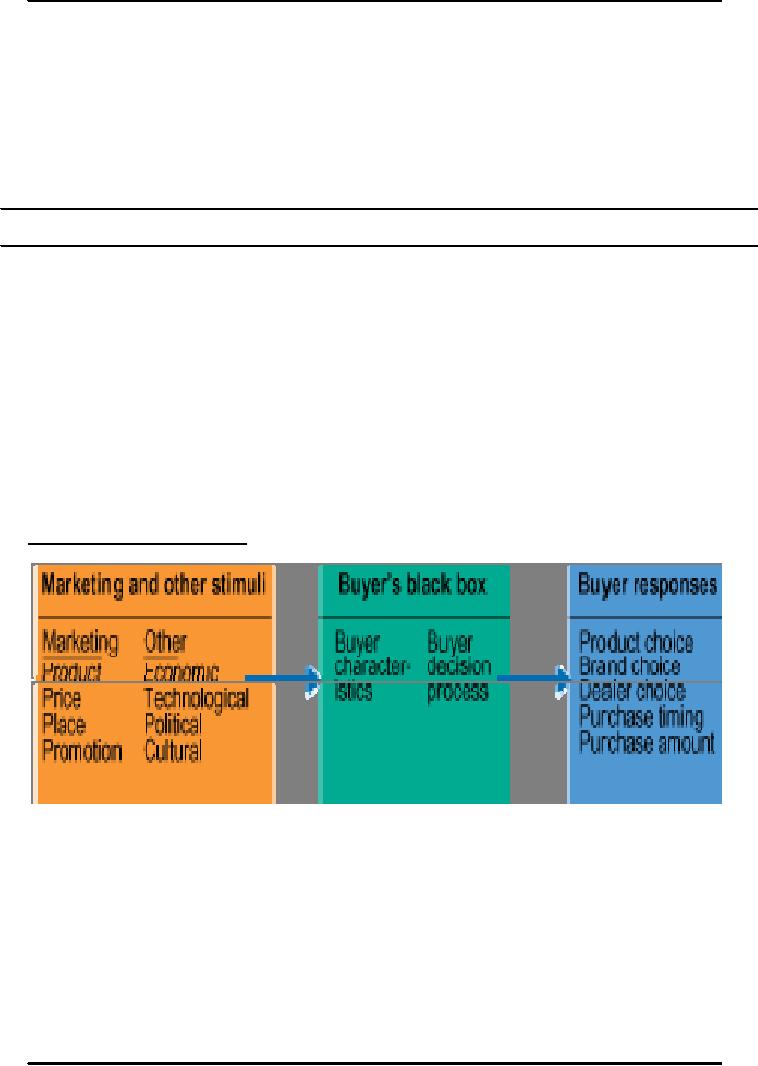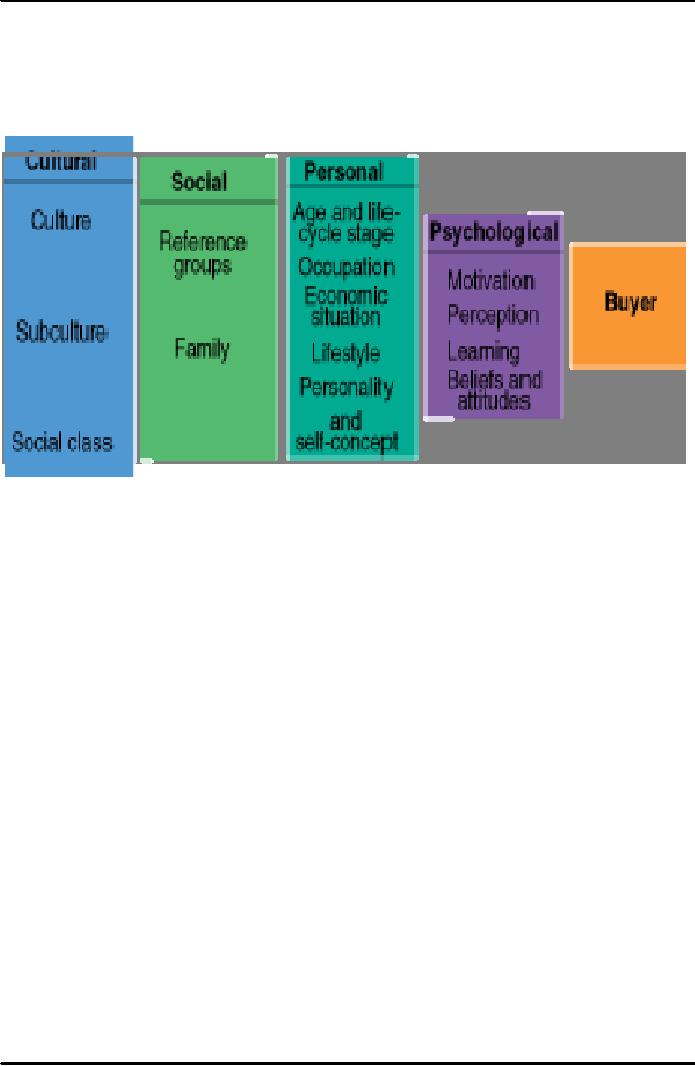 |

Principles
of Marketing MGT301
VU
Lesson
14
Lesson
overview and learning objectives:
In
last Lesson we discussed the
Consumer Markets and consumer behavior
and its importance
and
applications
for the marketing process.
Today we will be continuing
the same topic and
will discuss
the
Consumer buying model. Some factors
that can influence the
consumer decision regarding
purchases
will also be discussed in today's
Lesson.
So
our today's topic is:
CONSUMER
BUYING BEHAVIOR:
A.
Model of consumer
behavior
Consumers
make many buying decisions
every day. Most large
companies research consumer
buying
decisions in great detail to
answer questions about what
consumers buy, where they
buy,
how
and how much they
buy, when they buy,
and why they buy. Marketers
can study actual
consumer
purchases to find out what
they buy, where, and how
much. But learning about the
whys
of
consumer buying behavior is not so
easy--the answers are often
locked deep within
the
consumer's
head.
The
central question for marketers
is: How do consumers respond to various marketing
efforts the
company
might use? The company
that really understands how consumers
will respond to
different
product features, prices,
and advertising appeals has a
great advantage over
its
competitors.
The starting point is the
stimulus-response model of buyer behavior
shown in Figure
.
This figure shows that
marketing and other stimuli
enter the consumer's "black
box" and produce
certain
responses. Marketers must figure
out what is in the buyer's
black box.3
Model
of consumer behavior
Marketing
stimuli consist of the four
Ps: product, price, place,
and promotion. Other
stimuli
include
major forces and events in
the buyer's environment: economic, technological,
political, and
cultural.
All these inputs enter
the buyer's black box, where
they are turned into a
set of observable
buyer
responses: product choice,
brand choice, dealer choice,
purchase timing, and
purchase
amount.
The
marketer wants to understand how the
stimuli are changed into
responses inside the
consumer's
black box, which has
two parts. First, the
buyer's characteristics influence how he
or
she
perceives and reacts to the
stimuli. Second, the buyer's
decision process itself affects
the
buyer's
behavior. This chapter looks
first at buyer characteristics as
they affect buying
behavior,
and
then discusses the buyer
decision process.
62

Principles
of Marketing MGT301
VU
Consumer
purchases are influenced
strongly by cultural, social,
personal, and psychological
characteristics,
as shown in Figure For the
most part, marketers cannot
control such factors, but
they
must take them into
account.
B.
Factors influencing consumer
behavior
Markets
have to be understood
before
marketing strategies can be
developed.
People using consumer
markets
buy
goods
and
services
for
personal
consumption.
Consumers
vary tremendously in
age,
income,
education, tastes, and other
factors.
Consumer
behavior is influenced by the buyer's
characteristics and by the buyer's
decision process.
Buyer
characteristics include four
major factors: cultural, social,
personal, and psychological. We
can
say that following factors
can influence the Buying
decision of the
buyer:
a.
Cultural
b.
Social
c.
Personal
d.
Psychological
a.
Cultural Factors
Cultural
factors exert the broadest
and deepest influence on consumer
behavior. The marketer
needs
to understand the role played by
the buyer's culture, subculture,
and social class.
I.
Culture
Culture
is the most basic cause of a
person's wants and behavior.
Human behavior is largely
learned.
Growing up in a society, a child learns
basic values, perceptions, wants, and
behaviors
from
the family and other
important institutions. A person normally
learns or is exposed to
the
following
values: achievement and success,
activity and involvement,
efficiency and
practicality,
progress,
material comfort, individualism, freedom,
humanitarianism, youthfulness, and
fitness and
health.
Every
group or society has a
culture, and cultural
influences on buying behavior
may vary greatly
from
country to country. Failure to adjust to
these differences can result in
ineffective marketing or
embarrassing
mistakes. For example,
business representatives of a U.S.
community trying to
market
itself in Taiwan found this
out the hard way.
Seeking more foreign trade,
they arrived in
Taiwan
bearing gifts of green
baseball caps. It turned out
that the trip was
scheduled a month
before
Taiwan elections, and that
green was the color of
the political opposition
party. Worse yet,
the
visitors learned after the
fact that according to
Taiwan culture, a man wears
green to signify
that
his wife has been
unfaithful. The head of the
community delegation later noted, "I
don't know
whatever
happened to those green hats,
but the trip gave us an
understanding of the extreme
63

Principles
of Marketing MGT301
VU
differences
in our cultures." International
marketers must understand the
culture in each
international
market and adapt their marketing
strategies accordingly.
II.
Subculture
Each
culture contains smaller subcultures or groups of
people with shared value
systems based on
common
life experiences and situations.
Subcultures include nationalities, religions, racial
groups,
and
geographic regions. Many
subcultures make up important market
segments, and
marketers
often
design products and marketing
programs tailored to their needs.
Here are examples of
four
such
important subculture groups.
III.
Social Class
Almost
every society has some form
of social class structure.
Social Classes are society's
relatively
permanent
and ordered divisions whose
members share similar values,
interests, and behaviors.
Social
class is not determined by a single
factor, such as income, but is measured
as a combination
of
occupation, income, education, wealth,
and other variables. In some
social systems, members
of
different
classes are reared for
certain roles and cannot
change their social positions. Marketers
are
interested
in social class because
people within a given social
class tend to exhibit similar
buying
behavior.
Social
classes show distinct
product and brand
preferences in areas such as clothing,
home
furnishings,
leisure activity, and
automobiles.
b.
Social Factors
A
consumer's behavior also is influenced by
social factors, such as the consumer's small
groups,
family,
and social roles and
status.
I.
Groups
Many
small groups influence a person's
behavior. Groups that have a
direct influence and to
which
a
person belongs are called membership
groups. In contrast, reference groups
serve as direct (face-
to-face)
or indirect points of comparison or
reference in forming a person's attitudes
or behavior.
Reference
groups to which they do not belong
often influence people. Marketers
try to identify
the
reference groups of their target
markets. Reference groups expose a person
to new behaviors
and
lifestyles, influence the person's
attitudes and self-concept, and create
pressures to conform
that
may affect the person's
product and brand
choices.
The
importance of group influence
varies across products and
brands. It tends to be strongest
when
the product is visible to others
whom the buyer respects.
Manufacturers of products
and
brands
subjected to strong group
influence must figure out
how to reach opinion
leaders--people
within
a reference group who,
because of special skills, knowledge,
personality, or other
characteristics,
exert influence on
others.
Many
marketers try to identify
opinion leaders for their
products and direct marketing
efforts
toward
them. In other cases,
advertisements can simulate opinion
leadership, thereby reducing
the
need
for consumers to seek advice
from others.
The
importance of group influence
varies across products and
brands. It tends to be strongest
when
the product is visible to others
whom the buyer respects.
Purchases of products that
are
bought
and used privately are
not much affected by group
influences because neither
the product
nor
the brand will be noticed by
others.
II.
Family
Family
members can strongly
influence buyer behavior.
The family is the most
important
consumer
buying organization in society, and it
has been researched
extensively. Marketers are
interested
in the roles and influence
of the husband, wife, and
children on the purchase of
different
products
and services.
Husband-wife
involvement varies widely by
product category and by
stage in the buying
process.
Buying
roles change with evolving
consumer lifestyles.
Such
changes suggest that
marketers who've typically sold
their products to only women
or only
men
are now courting the
opposite sex. For example,
with research revealing that
women now
account
for nearly half of all
hardware store purchases,
home improvement retailers such as
Home
64

Principles
of Marketing MGT301
VU
Depot
and Builders Square have
turned what once were
intimidating warehouses into
female-
friendly
retail outlets. The new Builders
Square II outlets feature decorator
design centers at the
front
of the store. To attract
more women, Builders Square
runs ads targeting women in
Home,
House
Beautiful, Woman's Day, and
Better Homes and Gardens.
Home Depot even offers
bridal
registries.
Similarly,
after research indicated
that women now make up 34
percent of the luxury car
market,
Cadillac
has started paying more
attention to this important
segment. Male car designers at
Cadillac
are
going about their work
with paper clips on their
fingers to simulate what it feels like to
operate
buttons,
knobs, and other interior
features with longer fingernails.
The Cadillac Catera features
an
air-conditioned
glove box to preserve such items as
lipstick and film. Under
the hood, yellow
markings
highlight where fluid fills
go.
Children
may also have a strong
influence on family buying
decisions. For example, it
ran ads to
woo
these "back-seat consumers" in Sports
Illustrated for Kids, which
attracts mostly 8- to 14-
year-old
boys. "We're kidding ourselves
when we think kids aren't
aware of brands," says
Venture's
brand
manager, adding that even
she was surprised at how
often parents told her
that kids played a
tie-breaking
role in deciding which car
to buy.
In
the case of expensive
products and services,
husbands and wives often
make joint decisions.
III.
Roles and Status
A
person belongs to many groups--family,
clubs, organizations. The person's
position in each
group
can be defined in terms of both role
and status. A role consists
of the activities people
are
expected
to perform according to the
persons around them.
65
Table of Contents:
- PRINCIPLES OF MARKETING:Introduction of Marketing, How is Marketing Done?
- ROAD MAP:UNDERSTANDING MARKETING AND MARKETING PROCESS
- MARKETING FUNCTIONS:CUSTOMER RELATIONSHIP MANAGEMENT
- MARKETING IN HISTORICAL PERSPECTIVE AND EVOLUTION OF MARKETING:End of the Mass Market
- MARKETING CHALLENGES IN THE 21st CENTURY:Connections with Customers
- STRATEGIC PLANNING AND MARKETING PROCESS:Setting Company Objectives and Goals
- PORTFOLIO ANALYSIS:MARKETING PROCESS,Marketing Strategy Planning Process
- MARKETING PROCESS:Analyzing marketing opportunities, Contents of Marketing Plan
- MARKETING ENVIRONMENT:The Company’s Microenvironment, Customers
- MARKETING MACRO ENVIRONMENT:Demographic Environment, Cultural Environment
- ANALYZING MARKETING OPPORTUNITIES AND DEVELOPING STRATEGIES:MIS, Marketing Research
- THE MARKETING RESEARCH PROCESS:Developing the Research Plan, Research Approaches
- THE MARKETING RESEARCH PROCESS (Continued):CONSUMER MARKET
- CONSUMER BUYING BEHAVIOR:Model of consumer behavior, Cultural Factors
- CONSUMER BUYING BEHAVIOR (CONTINUED):Personal Factors, Psychological Factors
- BUSINESS MARKETS AND BUYING BEHAVIOR:Market structure and demand
- MARKET SEGMENTATION:Steps in Target Marketing, Mass Marketing
- MARKET SEGMENTATION (CONTINUED):Market Targeting, How Many Differences to Promote
- Product:Marketing Mix, Levels of Product and Services, Consumer Products
- PRODUCT:Individual product decisions, Product Attributes, Branding
- PRODUCT:NEW PRODUCT DEVELOPMENT PROCESS, Idea generation, Test Marketing
- NEW PRODUCT DEVELOPMENT:PRODUCT LIFE- CYCLE STAGES AND STRATEGIES
- KEY TERMS:New-product development, Idea generation, Product development
- Price the 2nd P of Marketing Mix:Marketing Objectives, Costs, The Market and Demand
- PRICE THE 2ND P OF MARKETING MIX:General Pricing Approaches, Fixed Cost
- PRICE THE 2ND P OF MARKETING MIX:Discount and Allowance Pricing, Segmented Pricing
- PRICE THE 2ND P OF MARKETING MIX:Price Changes, Initiating Price Increases
- PLACE- THE 3RD P OF MARKETING MIX:Marketing Channel, Channel Behavior
- LOGISTIC MANAGEMENT:Push Versus Pull Strategy, Goals of the Logistics System
- RETAILING AND WHOLESALING:Customer Service, Product Line, Discount Stores
- KEY TERMS:Distribution channel, Franchise organization, Distribution center
- PROMOTION THE 4TH P OF MARKETING MIX:Integrated Marketing Communications
- ADVERTISING:The Five M’s of Advertising, Advertising decisions
- ADVERTISING:SALES PROMOTION, Evaluating Advertising, Sales Promotion
- PERSONAL SELLING:The Role of the Sales Force, Builds Relationships
- SALES FORCE MANAGEMENT:Managing the Sales Force, Compensating Salespeople
- SALES FORCE MANAGEMENT:DIRECT MARKETING, Forms of Direct Marketing
- DIRECT MARKETING:PUBLIC RELATIONS, Major Public Relations Decisions
- KEY TERMS:Public relations, Advertising, Catalog Marketing
- CREATING COMPETITIVE ADVANTAGE:Competitor Analysis, Competitive Strategies
- GLOBAL MARKETING:International Trade System, Economic Environment
- E-MARKETING:Internet Marketing, Electronic Commerce, Basic-Forms
- MARKETING AND SOCIETY:Social Criticisms of Marketing, Marketing Ethics
- MARKETING:BCG MATRIX, CONSUMER BEHAVIOR, PRODUCT AND SERVICES
- A NEW PRODUCT DEVELOPMENT:PRICING STRATEGIES, GLOBAL MARKET PLACE